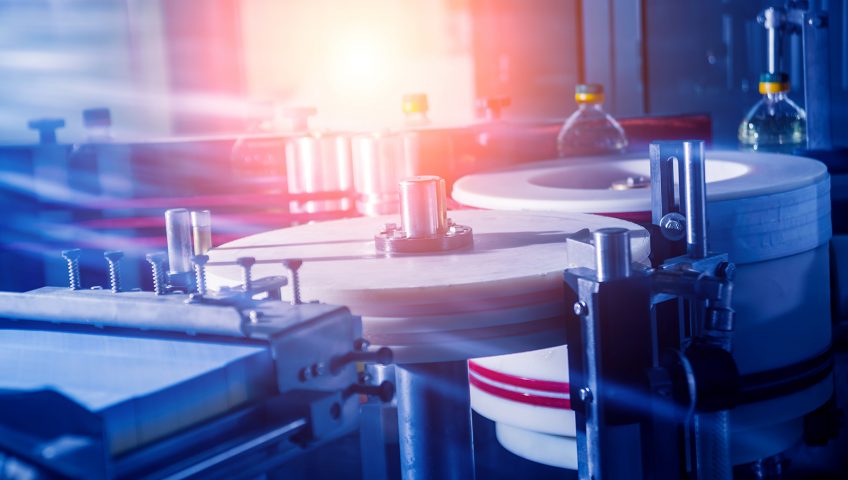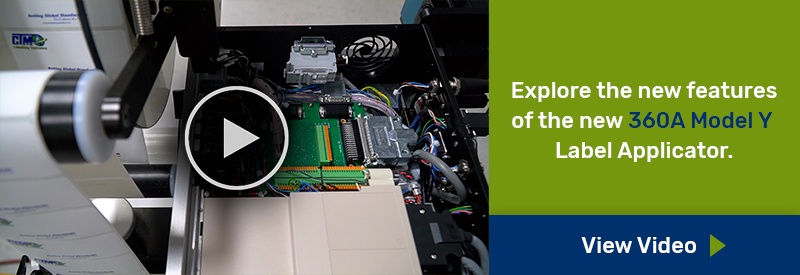
Automatic Label Applicators: Features and Benefits
There’s no one-size-fits-all solution for product labeling. When you choose a label application system, you have to factor in the size and shape of the containers, as well as what you want on your labels and where you want them placed. This means you have several equipment and configuration options when you buy a high-speed, automatic label applicator. What do these features do, and which ones do you need for your products?
→ [Free Video] Learn about the new features of the 360a Model Y Applicator! Watch the video now to learn about the benefits.
Which Labels Can I Use With a Pressure Sensitive Label Applicator?
A pressure-sensitive label applicator can apply any label as long as it fits the machine (with just one exception). This lets you adjust coatings or print and label stock as needed without modifying the machine. We make machines that store calibration settings so you can switch between labels and containers. This lets you cover multiple lines using one labeler with minimal downtime between product runs.
What’s the exception? Clear labels. Standard machines use a light-based sensor to determine the position of the label. If you want to use clear labels on your products, you need a capacitive sensor. This sensor measures changes in material thickness using electrical conductivity. This sensor can differentiate between the label and the backing paper. These sensors work with clear or opaque labels and can be added to most of our labeling machines.
Automatic Labeling Machines vs Semi-Automatic
How do you only partially automate labeling? Both automatic and semi-automatic machines apply labels automatically. However, while automatic labelers load using a conveyor belt, a semi-automatic machine is loaded externally. It can either load by hand or by lining up a conveyor belt from another machine with the labeler’s hopper. Semi-automatic machines are ideal for small-scale production or products that need a final inspection before labeling.
Label Application Methods: Wiping, Tamping and Blowing
There are several ways a label applicator machine can place a self-adhesive label on a container, and each method works particularly well for a specific application. We build our machines for ease of use so you can choose the best application method for your containers and packaging line.
Merge
Also called “wipe-on,” this method matches the container speed to the label dispensing speed. As the label rolls off of the backing paper, it’s pressed onto the container. Some systems capture the container and move it across the applicator, allowing fluctuations in product loading speed. This application method is commonly used for wrap-around labels found on round bottles, vials, and other cylindrical containers.
Air-Blow
A gust of air pushes the label onto the container at any angle or speed. This system requires compressed air, so you’ll need an air source for your labeling machine.
Tamp-blow
The applicator uses a muffin fan to suction the label onto the tamp pad, keeping it in place as the arm moves into position. The vacuum is released and a blast of compressed air blows the label onto the container. This method works great for odd-shaped containers.
Learn more about these application methods in our in-depth guide.
Label Positioning and Label Applicators
Labels can either be applied to one side of the container or wrapped around. Wrap labels are commonly used on bottles, acting as both a front and back label. However, they also work for boxes. The choice comes down to visibility and complexity. If you want to use a single label that wraps around two or three sides of a box, you only need one applicator. If you want separate front and back labels, you need a machine with two applicators. Need cover, neck or tamper-evident labels? You’ll need even more applicators. Fortunately, most machines are adjustable and scalable, letting you add more applicators to the labeling equipment as needed.
For example, our vertical trunnion roller labeler uses a design that allows several label configurations for round containers. A wrap label goes around the bottle. Normally, this requires a long pitch that takes up floor space and can cause sagging and skewing. This labeler uses rollers to capture the bottle during label application, keeping it stable. Front and back labels are applied at a second station. A hold-down belt keeps the bottle in position while the labels are wiped onto the container. This guarantees even positioning between the two labels. Want to secure the lid? A tamper-evident label is applied over the top of the lid and down the sides of the neck. A second label is then wrapped around the neck to secure the tamper-evident label. Depending on which label options you choose, your bottle labeling machine will have between one and five label applicators.
Print and Apply Labelers: Adding Unique Information to Your Labels
Do you need to add lot numbers, expiration dates, addresses or other unique information to your package labels? A print and apply labeling machine lets you add text and graphics to each label before application. This machine has a print engine and a programmable logic controller (PLC). The PLC stores label information and generate text and barcodes. The PLC can act alone, applying set information like dates or sequential serial numbers. It also connects to your operating technology system. This lets you send unique information to the PLC for each container, like lot numbers and shipping addresses.
A print engine is an industrial printer built to meet the speed and operating requirements of your labeling system. There are two methods these engines use for label printing: direct thermal and thermal transfer. Direct thermal uses heat to change the color of thermal paper. This is the same technology used to print receipts. Thermal paper fades and turns black with age, so it should only be used for short-term labelings, like address labels. Thermal transfer uses heat to melt ink from a ribbon onto the label. This creates a permanent mark that won’t fade with age. However, application costs are higher, since you need to factor in label replacements.
We offer labelers with print engines from Zebra and Sato. Each labeling system has different options for speed, print quality and label sizes.
Find the Right Labeling Solution for Your Business
Not sure what type of labeling system you need for your business? Contact us, and we’ll connect you with your local distributor. They’ll evaluate your production system and label requirements, helping you create a state-of-the-art high-performance solution tailored to your labeling needs. Whether you need a semi or fully-automatic label applicator, your labeling needs are met at CTM.





